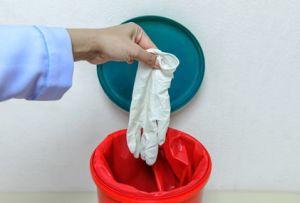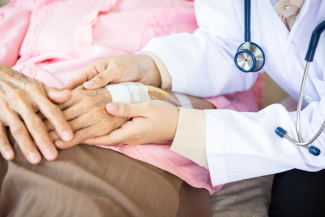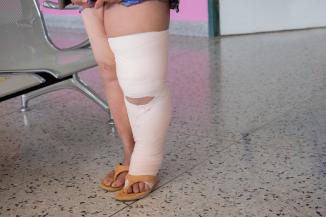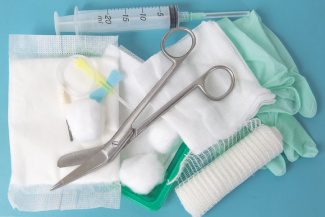Waste Not Want Not: A Look at Avoiding Medical Supply Waste
May 12, 2017
Like many people, you might go to recycling every month or so and be proud to deliver a few black bags of rubbish, and recycle most everything else. Many of you may have a thriving compost heap (mine is frequented by the biggest and fattest groundhog in the universe who eats produce instead of garbage). Like me, you might think of yourself as a responsible dweller of planet earth.
Then you go to work.
Examples Of Medical Supply Waste
It is truly shocking how much plastic we use and how much medical supply waste there is. From gloves that we wear to touch a patient's skin, to the sterile packed scissors that we are meant to dispose of into the sharps after use. A friend recently took 100 to Haiti after washing and boiling them for 20 minutes.
Some examples of medical supply waste are; nurse enters a room and grabs gloves from the box on the wall (sorry… gels her hands and rubs them till dry then dons the gloves), a couple drop to the floor. Nurse says hello and starts the patient assessment, gives an insulin shot, gives some meds down a nasogastric tube, checks vaginal discharge, and notices the foam dressing over a stage 3 pressure injury has rolled and needs replacing. How many gloves are really needed? 3? 14? Why do we need gloves on when we enter a room to assess a patient? Standard precautions dictate that gloves are required when it is expected that blood or body fluids may contaminate our hands.
Then there is the overstocked room and the discharged patient. It is stunning how many perfectly good supplies are disposed of that could be kept: dressings such as silver absorbent and bordered foam, catheters, full rolls of tape, foam wedges, chux and briefs.
Solving Medical Supplies Management Issues for Less Waste
Next, you have the equipment items that are ordered and delivered to the room but aren't needed or wanted. A good example of solving this supplies management issue is a group of managers who were told they could almost halve their cost on the soft offloading heel boots used. They assumed it would mean changing to a less expensive version, but were assured it would be no problem to keep the same Rolls Royce boots and still halve the cost. It was explained that nearly all the patients using the boots were meant to be positioned off their coccyx, so most would have only one leg offloaded with a pillow, negating the need for two boots. This required a major system change, as the product ordering was in the computer as a pair. The change over into practice took about three years but money was saved.
Another example of medical waste is when supplies are taken into the room and duplicated because there is not a designated place for them, so more and more are brought in. This is so common, it is scary how much money is wasted and how much plastic is added to the waste stream. Again, this is a systems issue. If the patient needs a dimethicone protective skin barrier cream, there should be one in the room. But no, there may be as many as six, including a few other creams people took in accidentally because they are color blind, or they use it to mix with another one (because it smells better). Having specific places for such medical supplies is a systematic nightmare and requires policing, as some staff will hide their stash in the place they like to keep it (so they know it will be there, right?)
Using incorrect equipment for the job can add to the medical supply waste particularly when guessing a size instead of measuring first. Of course, one reason for not measuring is that the nurse has to go to the other end of the floor and find a tape measure and then go all the way back to get the correct size. Much easier to guess and take a selection just in case (and, "Ooops! No time to return them").
Solutions to Medical Waste in Wound Management
The Omnicel style of supplies storage was intended to help prevent waste, but can be likened to employing a painter to paint your home and locking all the supplies in a password protected cupboard in your locked garage. The life of a busy nurse is hard enough, why make it harder by double locking away the tools of the trade?
Having a workable system for keeping opened dressings for the next dressing change is important. Medical supply waste occurs when opened supplies spill their contents and contaminate the dressing. A wound dressing that is dry can be cut to size for subsequent dressing changes with sterile scissors (saves on subsequent scissors being needed) and the original packet taped closed. The development of a dressing supplies box could save time, as well as money and supplies. Much time is wasted searching for supplies in cupboards, bedside stands and stuffed boxes full of last month's dressings.
Last but not least is the veteran patient under the care of the VA. Experience in the community nursing setting has made it clear that just three veterans with wound care needs could open a wound care center and stock it for a year. Reminiscent of the MASH episode where Hawkeye Pierce, surgeon extraordinaire, builds a monumental structure out of over-ordered, not-required tongue depressors.
Patients are given quantities of dressings far beyond what they need, or what is reasonable. Last week I cut a 1cmx1cm piece of a silver absorbent dressing from a 10cmx10cm sheet for a small toe wound of a VA patient. He had a large bag with twenty of these (at about $10 each). There were two boxes of 4cmx4cm sterile gauze for cleaning, two boxes of sterile 2cmx2cm gauzes used as cover dressings, a large bottle of cleanser, and twenty 2" wide bandages (wraps). Our tax dollars at work! On assessing the wound, showering would have been fine and a more appropriately secured foam with a few strips of Hypafix or Coban would have saved around $200. A unit manager I knew did a poster on the cost of a variety of medical supplies, as most staff are not aware, and it helps to reduce cost and therefore also medical supply waste.
There are islands of plastic debris in our oceans, and there is evidence of marine life ingesting sufficient quantities, causing them permanent damage, yet we are still polluting our oceans with medical supply waste. Don't get me wrong, it is good that we no longer must rely on questionable infection control practices, such as sharing equipment that may be contaminated, reusing catheters and using our own scissors patient to patient. Maybe it's time for nursing to develop some systems to optimize organization, save time, prevent medical supply waste and ensure the patient gets what they need, and help reduce pollution in the process.
About the Author
Margaret Heale has a clinical consulting service, Heale Wound Care in Southeastern Vermont and draws on her extensive experience as a wound, ostomy and continence nurse in acute and long-term care settings to provide education and holistic care in her practice.
The views and opinions expressed in this content are solely those of the contributor, and do not represent the views of WoundSource, HMP Global, its affiliates, or subsidiary companies.










